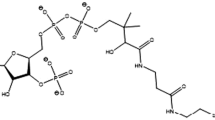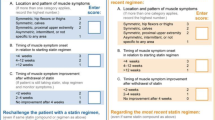Abstract
Statin-associated muscle symptoms are a relatively common condition that may affect 10% to 15% of statin users. Statin myopathy includes a wide spectrum of clinical conditions, ranging from mild myalgia to rhabdomyolysis. The etiology of myopathy is multifactorial. Recent studies suggest that statins may cause myopathy by depleting isoprenoids and interfering with intracellular calcium signaling. Certain patient and drug characteristics increase risk for statin myopathy, including higher statin doses, statin cytochrome metabolism, and polypharmacy. Genetic risk factors have been identified, including a single nucleotide polymorphism of SLCO1B1. Coenzyme Q10 and vitamin D have been used to prevent and treat statin myopathy; however, clinical trial evidence demonstrating their efficacy is limited. Statin-intolerant patients may be successfully treated with either low-dose statins, alternate-day dosing, or using twice-weekly dosing with longer half-life statins. An algorithm is presented to assist the clinician in managing myopathy in patients with dyslipidemia.

Similar content being viewed by others
References
Papers of particular interest, published recently, have been highlighted as: •• Of major importance
Law M, Rudnicka AR: Statin safety: a systematic review. Am J Cardiol 2006, 97:52C–60C.
Mitka M: Expanding statin use to help more at-risk patients is causing financial heartburn. JAMA 2003, 290:2243–2245.
Pasternak RC, Smith SC Jr, Bairey-Merz CN, et al.: ACC/AHA/NHLBI Clinical Advisory on the Use and Safety of Statins. Circulation 2002, 106:1024–1028.
McKenney JM, Davidson MH, Jacobson TA, Guyton JR, National Lipid Association Statin Safety Assessment Task Force: Final conclusions and recommendations of the National Lipid Association Statin Safety Assessment Task Force. Am J Cardiol 2006, 97:89C–94C.
Harper CR, Jacobson TA: The broad spectrum of statin myopathy: from myalgia to rhabdomyolysis. Curr Opin Lipidol 2007, 18:401–408.
Gaist D, Rodriguez LA, Huerta C, et al.: Lipid-lowering drugs and risk of myopathy: a population-based follow-up study. Epidemiology 2001, 12:565–569.
Shanahan RL, Kerzee JA, Sandhoff BG, et al.: Low myopathy rates associated with statins as monotherapy or combination therapy with interacting drugs in a group model health maintenance organization. Pharmacotherapy 2005, 25:345–351.
Bruckert E, Hayem G, Dejager S, et al.: Mild to moderate muscular symptoms with high-dosage statin therapy in hyperlipidemic patients--the PRIMO study [see comment]. Cardiovasc Drugs Ther 2005, 19:403–414.
Mohaupt MG, Karas RH, Babiychuk EB, et al.: Association between statin-associated myopathy and skeletal muscle damage. CMAJ Can Med Assoc J 2009, 181:E11–E18.
Hodel C: Myopathy and rhabdomyolysis with lipid-lowering drugs. Toxicol Lett 2002, 128:159–168.
Flint OP, Masters BA, Gregg RE, Durham SK: Inhibition of cholesterol synthesis by squalene synthase inhibitors does not induce myotoxicity in vitro. Toxicol Appl Pharmacol 1997, 145:91–98.
Baker SK: Molecular clues into the pathogenesis of statin-mediated muscle toxicity. Muscle Nerve 2005, 31:572–580.
Marcoff L, Thompson PD: The role of coenzyme Q10 in statin-associated myopathy: a systematic review [see comment]. J Am Coll Cardiol 2007, 49:2231–2237.
Baer AN, Wortmann RL: Myotoxicity associated with lipid-lowering drugs. Curr Opin Rheumatol 2007, 19:67–73.
Päivä H, Thelen KM,Van Coster R, et al.: High-dose statins and skeletal muscle metabolism in humans: a randomized, controlled trial. Clin Pharmacol Ther 2005, 78:60–68.
Laaksonen R, Jokelainen K, Sahi T, et al.: Decreases in serum ubiquinone concentrations do not result in reduced levels in muscle tissue during short-term simvastatin treatment in humans. Clin Pharmacol Ther 1995, 57:62–66.
Schaefer WH, Lawrence JW, Loughlin AF, et al.: Evaluation of ubiquinone concentration and mitochondrial function relative to cerivastatin-induced skeletal myopathy in rats. Toxicol Appl Pharmacol 2004, 194:10–23.
Dirks AJ, Jones KM: Statin-induced apoptosis and skeletal myopathy. Am J Physiol Cell Physiol 2006, 291:C1208–1212.
Guijarro C, Blanco-Colio LM, Ortego M, et al.: 3-Hydroxy-3-methylglutaryl coenzyme a reductase and isoprenylation inhibitors induce apoptosis of vascular smooth muscle cells in culture. Circ Res 1998, 83:490–500.
Sirvent P, Mercier J, Vassort G, Lacampagne A: Simvastatin triggers mitochondria-induced Ca2+ signaling alteration in skeletal muscle. Biochem Biophys Res Commun 2005, 329:1067–1075.
Toth PP, Harper CR, Jacobson TA: Clinical characterization and molecular mechanisms of statin myopathy. Expert Rev Cardiovasc Ther 2008, 6:955–969.
Brewer HB Jr: Benefit-risk assessment of rosuvastatin 10 to 40 milligrams. Am J Cardiol 2003, 92:23 K–29 K.
•• Jacobson TA: Toward “pain-free” statin prescribing: clinical algorithm for diagnosis and management of myalgia [see comment]. Mayo Clin Proc 2008, 83:687–700. This is an excellent overview of statin-induced myalgia with one of the first published algorithms on myalgia management strategies.
Venero CV, Thompson PD: Managing statin myopathy. Endocrinol Metab Clin North Am 2009, 38:121–136.
Vladutiu GD, Simmons Z, Isackson PJ, et al.: Genetic risk factors associated with lipid-lowering drug-induced myopathies. Muscle Nerve 2006, 34:153–162.
•• Group SC, Link E, Parish S, et al.: SLCO1B1 variants and statin-induced myopathy--a genomewide study [see comment]. N Engl J Med 2008, 359:789–799. This was one of the first studies to identify genetic predictors of myopathy, such as specific defects in the statin organic anion transporting polypeptide system responsible for hepatic uptake of statins.
Harper CR, Jacobson TA: Managing dyslipidemia in chronic kidney disease. J Am Coll Cardiol 2008, 51:2375–2384.
Graham DJ, Staffa JA, Shatin D, et al.: Incidence of hospitalized rhabdomyolysis in patients treated with lipid-lowering drugs. JAMA 2004, 292:2585–2590.
Jones PH, Davidson MH: Reporting rate of rhabdomyolysis with fenofibrate + statin versus gemfibrozil + any statin. Am J Cardiol 2005, 95:120–122.
Prueksaritanont T, Zhao JJ, Ma B, et al.: Mechanistic studies on metabolic interactions between gemfibrozil and statins. J Pharmacol Exp Ther 2002, 301:1042–1051.
Caso G, Kelly P, McNurlan MA, Lawson WE: Effect of coenzyme q10 on myopathic symptoms in patients treated with statins. Am J Cardiol 2007, 99:1409–1412.
Young JM, Florkowski CM, Molyneux SL, et al.: Effect of coenzyme Q(10) supplementation on simvastatin-induced myalgia. Am J Cardiol 2007, 100:1400–1403.
Lips P: Vitamin D physiology. Prog Biophys Mol Biol 2006, 92:4–8.
Bischoff-Ferrari HA, Dietrich T, Orav EJ, et al.: Higher 25-hydroxyvitamin D concentrations are associated with better lower-extremity function in both active and inactive persons aged > or =60 y. Am J Clin Nutr 2004, 80:752–758.
Erkal MZ, Wilde J, Bilgin Y, et al.: High prevalence of vitamin D deficiency, secondary hyperparathyroidism and generalized bone pain in Turkish immigrants in Germany: identification of risk factors. Osteoporos Int 2006, 17:1133–1140.
Ahmed W, Khan N, Glueck CJ, et al.: Low serum 25 (OH) vitamin D levels (<32 ng/mL) are associated with reversible myositis-myalgia in statin-treated patients. Transl Res 2009, 153:11–16.
Gazi IF, Daskalopoulou SS, Nair DR, Mikhailidis DP: Effect of ezetimibe in patients who cannot tolerate statins or cannot get to the low density lipoprotein cholesterol target despite taking a statin. Curr Med Res Opin 2007, 23:2183–2192.
Stein EA, Ballantyne CM, Windler E, et al.: Efficacy and tolerability of fluvastatin XL 80 mg alone, ezetimibe alone, and the combination of fluvastatin XL 80 mg with ezetimibe in patients with a history of muscle-related side effects with other statins. Am J Cardiol 2008, 101:490–496.
Backes JM, Venero CV, Gibson CA, et al.: Effectiveness and tolerability of every-other-day rosuvastatin dosing in patients with prior statin intolerance. Ann Pharmacother 2008, 42:34–346.
Athyros VG, Tziomalos K, Kakafika AI, et al.: Effectiveness of ezetimibe alone or in combination with twice a week Atorvastatin (10 mg) for statin intolerant high-risk patients. Am J Cardiol 2008, 101:483–485.
Rivers SM, Kane MP, Busch RS, et al.: Colesevelam hydrochloride-ezetimibe combination lipid-lowering therapy in patients with diabetes or metabolic syndrome and a history of statin intolerance. Endocr Pract 2007, 13:11–16.
Lu Z, Kou W, Du B, et al.: Effect of Xuezhikang, an extract from red yeast Chinese rice, on coronary events in a Chinese population with previous myocardial infarction. Am J Cardiol 2008, 101:1689–1693.
Becker DJ, Gordon RY, Halbert SC, et al.: Red yeast rice for dyslipidemia in statin-intolerant patients: a randomized trial [see comment]. [summary for patients in Ann Intern Med. 2009 Jun 16;150(12):I28; PMID: 19528545]. Ann Intern Med 2009, 150:830–839.
Guyton JR: Benefit versus risk in statin treatment. Am J Cardiol 2006, 97:95C–97C.
Wilt TJ, Bloomfield HE, MacDonald R, et al.: Effectiveness of statin therapy in adults with coronary heart disease. Arch Intern Med 2004, 164:1427–1436.
Disclosure
No potential conflicts of interest relevant to this article were reported.
Author information
Authors and Affiliations
Corresponding author
Rights and permissions
About this article
Cite this article
Harper, C.R., Jacobson, T.A. Evidence-Based Management of Statin Myopathy. Curr Atheroscler Rep 12, 322–330 (2010). https://doi.org/10.1007/s11883-010-0120-9
Published:
Issue Date:
DOI: https://doi.org/10.1007/s11883-010-0120-9




